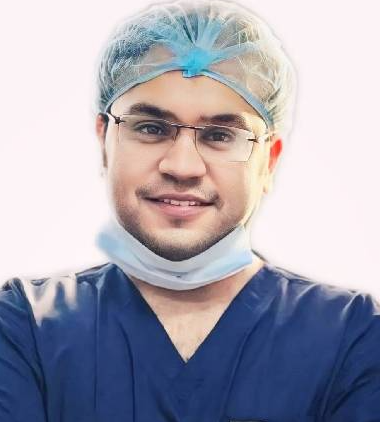Decompressive Craniectomy - Meaning, Surgery Procedure, Side Effects

Treatment Duration
3 Hours
------ To ------5 Hours
Treatment Cost
₹ 80,000
------ To ------₹ 3,00,000

Table of Contents
- What is Decompressive Craniectomy
- Conditions treated with Decompressive Craniectomy
- Who needs Decompressive Craniectomy?
- How is Decompressive Craniectomy performed?
- What to expect before and on the day of Decompressive Craniectomy?
- What to expect after Decompressive Craniectomy?
- Benefits of Decompressive Craniectomy
- Risks and complications of Decompressive Craniectomy
- Risks of delayed Decompressive Craniectomy
- Cost of Decompressive Craniectomy
Decompressive Craniectomy is a surgical procedure done to relieve pressure on the brain. The increased pressure in the brain can damage the nerves and tissue in the brain. It can cause irreversible brain damage and eventually the person’s death.
Decompressive craniectomy usually takes about 3 to 5 hours to complete. This surgical procedure can be done as a primary or a secondary procedure. This procedure serves as an emergency life-saver method.
| Surgery Name | Decompressive Craniectomy |
| Diseases Treated | Stroke, Cerebral oedema, Intracranial hematoma |
| Benefits of the Surgery | Improves blood flow, reduces intracranial pressure, reduces mortality |
| Treated by | Neurologist |
You can check Decompressive Craniectomy Cost here.
What is Decompressive Craniectomy
Decompressive Craniectomy is a surgical procedure that involves the temporary removal of the skull to relieve pressure on the brain. It is done as an emergency procedure when the skull needs to be opened quickly to prevent complications from swelling. This procedure serves as an emergency life-saver method.
Anatomy and Physiology of the Brain
The brain is one of the largest organs of the human body, which comprises more than 100 billion nerves that work together and help in communication. The different specialised areas of the brain are
- Cortex: The outermost layer of the brain cells is called the cortex, which controls thinking and voluntary movements.
- Cerebellum: It lies at the base and the back of the brain. It is responsible for coordination, posture, and balance. It consists of the cerebellar cortex and cerebellar nuclei. The cerebellum is connected to the brainstem part by the structure called cerebellar peduncles.
- Brain stem: The brain stem is between the spinal cores and the base of the cerebellum. It helps in essential functions such as sleeping and breathing. It consists of the midbrain, pons, and medulla.
- The Cerebrum: This is divided into the right hemisphere and the left hemisphere. It consists of many ridges, folds, and convolutions on its surface. The function of the cerebrum is to coordinate and process the sensory and motor functions of the body.
The brain is also divided into several lobes:
- The frontal lobes are responsible for judgment and problem-solving.
- The parietal lobes are responsible for managing body position, sensation, and handwriting.
- Temporal lobes are involved in hearing and memory.
- Occipital lobes are involved in the brain's visuals.
Expert Doctors (10)
NABH Accredited Hospitals (10)


Conditions treated with Decompressive Craniectomy
Generally, decompressive craniectomy is done when other methods fail to relieve the pressure from the brain. This also helps in treating other conditions which include:
- Stroke
- Cerebral oedema: fluid build-up in the brain
- Intracranial hematoma: pooling of blood inside the skull
- Traumatic brain injuries
Who needs Decompressive Craniectomy?
Decompressive craniectomy is performed in adults and children who are victims of:
- Traumatic brain injury
- Stroke
- Chiari Malformation
- Other conditions associated with raised intracranial pressure
How is Decompressive Craniectomy performed?
Decompressive craniectomy can be done as a primary or a secondary procedure. The procedure usually takes about 3 to 5 hours to complete depending on the patient's age, medical condition of the patient and the complexity of the case. The procedure is done under general anaesthesia to keep the patient comfortable. A Neurologist along with other professional medical staff performs this procedure. The following steps are involved in the procedure:
- The patient will be taken to the operating theatre, and the surgeon will administer general anaesthesia to the patient.
- The vital signs of the patient will be continuously monitored throughout the process.
- The patient will also be given antibiotics intravenously to prevent the development of any infection during the surgery, and your vitals will also be monitored.
- The neurologist will shave and clean the portion of your affected scalp area.
- Once done, the neurologist will make an incision on the cleaned portion of the scalp and will move the skin and tissue aside.
- The doctor will make the holes into your skull using the medical-grade drill as the skull is made of hard bone.
- The doctor then uses the saw to cut between the holes in the skull until an entire piece of the skull can then be removed.
- The removed bone is stored in the freezer, which is replaced after the swelling in the brain subsides.
- The doctor will cut the tissue and make the necessary repairs to stop bleeding and reduce swelling.
- Finally, the neurologist will place a mesh piece on the incision and close the wound using stitches or sutures.
What to expect before and on the day of Decompressive Craniectomy?
Before the decompressive craniectomy, the doctor/surgeon will discuss and prepare the patient for the surgery. These steps often involve:
Before Decompressive Craniectomy
Before undergoing the decompressive craniectomy procedure, the patient can expect the following:
- The doctor will opt for appropriate procedures depending upon the condition.
- The doctor will perform some tests and will monitor your condition, and identify the right position for the surgery.
- The doctor will explain the complete procedure before the surgery to you or your family member.
- The staff will provide you with a consent form which you need to sign before the procedure is performed.
On the day of Decompressive Craniectomy
- The doctor will ask you or your family member about your medical history.
- The doctor may ask you not to eat or drink anything before the surgery.
- The medical staff will take a detailed computerized x-ray or pictures of the inside of your skull before the surgery.
- Once done, you will be asked to wear the hospital gown, and then you will be taken for surgery.
What to expect after Decompressive Craniectomy?
A patient who has undergone decompressive craniectomy can expect the following after the surgery:
The recovery process at the hospital
- You will be transferred to the Intensive Care Unit (ICU) after the surgery, where the medical staff will monitor your condition and vitals.
- You will be in hospital for weeks or more, depending on the severity of the injury or condition.
- Some people may remain unconscious for days or weeks after a decompressive craniectomy. You will be shifted to the general ward once the condition stabilises.
- You will be needed to wear a special helmet to protect the brain from any injury and allow it to heal.
- The doctor will schedule the follow-up surgery to replace the portion of the skull with the artificial plate or original bone once you fully recover.
- Once the condition stabilises, the patient will be discharged, and the doctor will also give some instructions for home care.
Recovery process/expectation after hospital discharge
- Instructions provided by the doctor must follow at home.
- The doctor will also prescribe some antibiotics and painkillers to relieve the pain after the surgery.
- The surgeon will advise you to avoid any rigorous activities, exercise, or any motion that may injure your head and delay the healing.
First follow-up appointment
The neurosurgeon will call you after two weeks or 15 days. You will have frequent follow up with the doctor in the first six months after the surgery. The doctor will perform some tests to check for the healing. If the pressure subsides and your condition stabilises, the doctor may perform an artificial skull replacement after a few months.
Benefits of Decompressive Craniectomy
Advantages of decompressive craniectomy include improved blood flow and perfusion, reduced intracranial pressure, and reduced mortality rate.
Risks and complications of Decompressive Craniectomy
Like any surgical procedure, decompressive craniectomy also has some risks and complications. These include:
- Seizures
- Vomiting
- Fever
- Shortness of the breath
When is consultation with the doctor needed?
Decompressive craniectomy is a complicated procedure and has a more extended recovery period. Kindly contact your doctor immediately if you face any complications after the surgery. Some of the risks and complications associated with decompressive craniectomy are:
- Seizures
- Vomiting
- Fever
- Shortness of the breath
- Drainage from the wound
- Redness around the incision or cut on the scalp
- Abnormal accumulation of the cerebrospinal fluid
- Reaction to the anaesthesia
- Inability to speak
- Partial or incomplete paralysis
- Heart attack
- Blood clot formation in the brain
- Bleeding around the meninges (layers of the brain)
- Infection in the spine or brain
Risks of delayed Decompressive Craniectomy
Decompressive Craniectomy procedure can increase the severity of the pain and discomfort.
- It will increase intracranial pressure, heavy bleeding, or increase intracranial hypertension inside the brain.
- It will eventually compress your brain and push it onto the brain stem, which can be fatal and leads to permanent brain damage.
- Patients may have extensive brain infarction and severe brain swelling.
- Can lead to nerve tract damage (axonal injury), and coagulopathy.
- Patients may have signs of brain damage: Coma, limb paralysis, respiratory paralysis, blindness, forgetfulness, personality changes.
- Patients may develop infections such as pneumonia, urinary tract infection, sepsis.
Cost of Decompressive Craniectomy
The cost of decompressive craniectomy ranges from ₹80,000 to ₹3,00,000. The cost varies based on the following factors:
- Age of the patient
- Type of the procedure done
- Technique and equipment used
- The medical condition of the patient
- The type of hospital facility availed - individual room or shared.
| Procedure Name | Cost Value |
| Decompressive Craniectomy | ₹80,000 to ₹3,00,000 |
Frequently Asked Questions (FAQ)
What are the myths versus facts about decompressive craniectomy?
- Myth: It is believed that decompressive craniectomy treats traumatic brain injury.
Fact: It is not the case. The decompressive craniectomy procedure does not directly treat the traumatic brain injury or the damage done to the brain. Rather, it is a procedure that prevents further brain damage that may occur due to swelling and subsequent squeezing of the brain tissues.
Last Updated on: 30 September 2022
Author
HexaHealth Care Team
HexaHealth Care Team brings you medical content covering many important conditions, procedures falling under different medical specialities. The content published is thoroughly reviewed by our panel of qualified doctors for its accuracy and relevance.
Latest Health Articles























